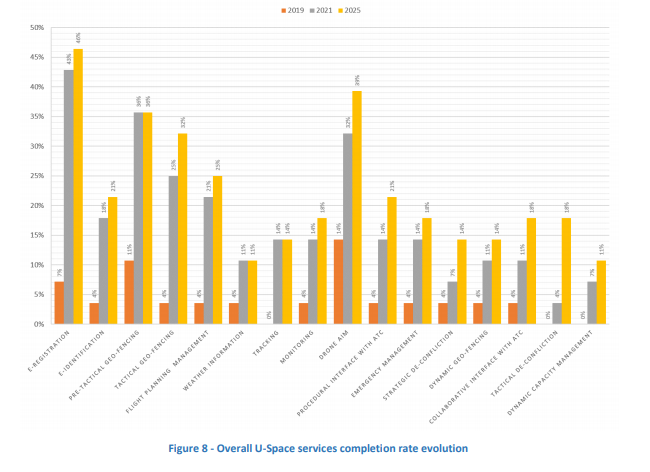Eurocontrol has issued a new edition of the U-space services Implementation Monitoring Report which assesses implementation progress of the main elements underlying the provision of U-space services enabling very low level (VLL) drone operations in the 30 Single European Sky (SES) area member states.
The report covers the results of an implementation survey carried out in the period December 2019 – April 2020 using a dedicated online monitoring tool and is available here. The report provides a snapshot of the level of maturity, with reference date December 2019, of the main elements underlying the provision of the services enabling VLL drone operations in the Single European Sky (SES) Area.
In total 148 representatives from EU SES national stakeholders were invited to provide implementation progress, as well as short to medium term planning information concerning implementation of U-space services in their national environment. 77% of the 30 EU SES area states responded.
Eurocontrol carried out an initial implementation survey, composed of 60 closed-ended questions derived from SESAR U-space Blueprint, covering 16 services, whose gradual implementation is planned in phases U1 (2019) to U3 (2025).
The results of the overall analysis show a non-uniform, slow implementation progress of the 16 U-space services expected to be provided in phases U1 (2019) to U3 (2025) of the U-space framework. However, the rate of planned activities increased compared to 2018, indicating that a larger number of stakeholders is taking steps forward into the implementation of many U-space services.
Eurocontrol notes negative completion trends were detected for a number of service elements compared with the last report edition. Such findings are due to the enlargement of the scope of the survey from the 28 EU Member States (ref. 2018) to the 30 EU SES Member States. It is also notable how some of the most active stakeholders did not provide any information, which also contributed to decrease completion rates. Even though the reporting process is still in his infancy, it benefited from the integration with the more mature, consolidated LSSIP mechanism in terms of both methodology ad resources allocation, which resulted in a more accurate picture of the U-space services implementation over the EU SES area. Due to the lack of information reported, the results should be considered a rather conservative estimate. In fact, although the implementation of many service elements is currently ongoing in several States, no assumptions were made on their deployment in absence of an expected full implementation date. Therefore, their completion could not contribute to the overall figures.
The image above the overall U-space services completion rate evolution taking into account the average progress of implementation of different service elements among SES Member States. As an illustration, the figure shows that 7% of Member States reported to have implemented E-registration by 2019, 43% plan to implement in by 2021 and 46% by 2025.
The report documents the progress made by states for each U-space capability, supported by data and graphics.
The final chapter provides an overview of the implementation of the U-space demonstration projects, involving organisations from the EU Member States, including implementation information concerning completed, ongoing, as well as planned demonstration projects.
For more information visit:




